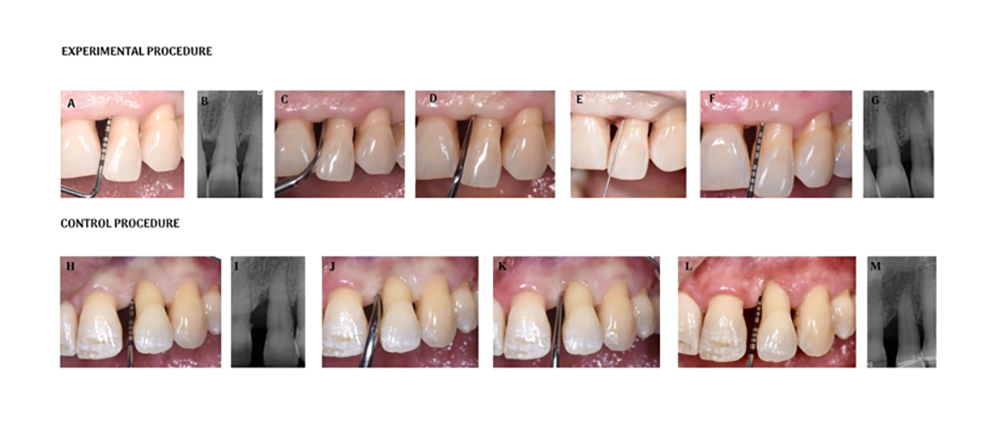
Issue No. 134
Summarised from Journal of Clinical Periodontology, Volume 52, Issue 2, February 2025, 310-322
Editor: Andreas Stavropoulos, chair, EFP scientific affairs committee
The potential benefits of hyaluronic acid in non-surgical treatment of periodontal intrabony defects
Authors: Vincenzo Iorio-Siciliano, Andrea Blasi, Leopoldo Mauriello, Giovanni E. Salvi, Luca Ramaglia, Anton Sculean
Background
Conventional periodontal treatment focuses on professional mechanical plaque removal, which has been demonstrated to be an effective means to control disease progression and restore periodontal health.
However, in cases involving residual pockets—probing depth (PD) ≥5mm associated with intrabony defects—that are characterized by vertical bone loss, the treatment approach becomes more complex. Traditionally, surgical intervention has been the preferred method for managing these defects, utilizing various regenerative biomaterials to promote bone regeneration.
In recent years, minimally invasive non-surgical techniques (MINST) have been investigated as an alternative approach to treating intrabony defects, leading to reduced patient discomfort while preserving gingival architecture. MINST employs delicate mechanical debridement with fine ultrasonic tips and mini-curettes, often performed under magnification to ensure precise instrumentation. Additionally, cross-linked hyaluronic acid (xHyA) has been proposed as an adjunctive treatment modality because of its ability to enhance wound healing, stabilize blood clots, and provide antimicrobial effects.
Several preclinical and clinical studies suggest that xHyA may aid in periodontal tissue regeneration by stimulating cell proliferation, angiogenesis, and osteogenesis. While the effectiveness of both MINST and xHyA as sole therapeutical approaches is well-supported in the literature, their combined efficacy in treating moderate intrabony defects remains unclear.
Aims
The aim of the study was to evaluate the clinical effectiveness of MINST with or without xHyA gel in treating moderate intrabony defects, with a primary focus on PD changes and additional clinical and radiographic parameters over a six-month period.
Materials and methods
The study was designed as a single-blinded, parallel-arm randomized controlled trial (RCT). A total of 42 patients were randomly assigned to the test group (MINST + xHyA) or the control group (MINST alone).
Inclusion criteria:
- Age ≥18 years.
- Diagnosis of stage III or IV periodontitis.
- Presence of moderate interdental intrabony defects (PD ≥5mm with an intrabony component ≥2mm).
- Single-rooted teeth or molars with ≤ class I furcation involvement.
- Only one defect per patient was treated, selecting the site with the deepest PD. If multiple sites had the same PD, the defect with the deepest radiographic intrabony component was chosen.
Exclusion criteria:
- Systemic diseases.
- Heavy smoking (≥10 cigarettes/day).
- Pregnancy or lactation.
- Extensive tooth mobility.
- Periodontal treatment within the past 12 months.
Treatment protocol:
- Initial phase: Supragingival professional mechanical plaque removal and oral-hygiene instructions.
- Subgingival mechanical debridement performed using ultrasonic scalers and Gracey mini-curettes.
- Test group: Received additional subgingival xHyA gel application after debridement.
- No antiseptic mouthwashes or systemic antibiotics were prescribed.
Clinical and radiographic assessments:
- Clinical parameters: PD, clinical attachment level (CAL), gingival recession (GR), bleeding on probing (BOP), full-mouth plaque score (FMPS), and full-mouth bleeding score (FMBS).
- Radiographic parameters: Defect fill (DF), Radiographic defect angle (RDA).
Follow-up evaluations:
- Conducted at one, three, and six months to monitor oral-hygiene maintenance and clinical outcomes.
- Radiographic evaluations at baseline and six months.

Results
- Of the 42 patients included, 38 completed the study.
- Both groups demonstrated statistically significant improvements in PD reduction, CAL gain, and BOP reduction. At three months, the test group exhibited significantly greater PD reduction and CAL improvement compared to the control group, although these differences were not maintained at six months.
- GR remained unchanged between groups, indicating that neither treatment caused significant soft-tissue alterations.
- Radiographic analysis revealed greater DF at six months in the test group compared to the control group, while changes in the RDA did not differ significantly between groups.
- No adverse events or complications were recorded during the study.
- A higher percentage of sites achieved pocket closure (PD ≤4mm) in the test group at three months (84.2% vs. 10.5%), though this advantage diminished at six months (78.9% vs. 63.1%). Overall, both treatment protocols led to meaningful clinical and radiographic improvements, with xHyA showing an initial advantage that diminished over time.
Limitations
- The study’s six-month follow-up period limits the ability to assess the long-term outcomes of the treatments.
- As it was a single-center study, the findings may not be generalizable.
- Although the sample size was adequately powered, it was still relatively small, which could limit the detection of subtle differences between the groups.
- The absence of patient-reported outcomes (e.g., pain perception, quality of life) means that subjective experiences were not considered in the evaluation.
Conclusions and impact
- The findings of this study suggest that MINST is an effective non-surgical approach for treating moderate intrabony defects, leading to significant clinical and radiographic improvements.
- The adjunctive use of xHyA gel enhanced early healing and provided superior outcomes at three months; however, these benefits were not statistically significant at six months.
- While xHyA may accelerate initial tissue healing, its long-term advantages over MINST alone remain uncertain.
- Further research with extended follow-up periods is necessary to determine whether xHyA contributes to sustained regenerative benefits.
- Clinicians may consider using xHyA in cases where faster initial healing is desirable, but its routine application for intrabony defects requires further validation.
This study supports MINST as a viable treatment for moderate intrabony defects (PD ≥5mm with an intrabony component ≥2mm), offering a short-term favourable treatment outcome. The adjunctive use of xHyA may be beneficial in cases requiring accelerated healing; however, long-term clinical advantages remain inconclusive.
Rapporteurs: Chariklia Neophytou and Elpiniki Vlachodimou, supervised by Professor Ioannis Vouros.
Affiliation: Postgraduate programme in periodontology, Aristotle University of Thessaloniki, Greece.
With kind permission from Wiley Online Library. Copyright © 1999-2025 John Wiley & Sons, Inc. All rights reserved




